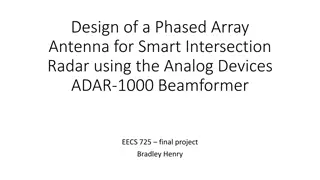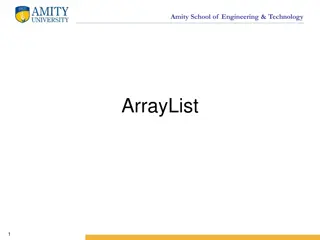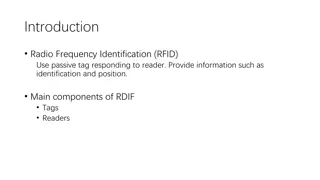Metamaterial-Based Series Connected Rectangular Patch Antenna Array for UHF RFID Readers
The metamaterial-based UHF RFID reader antenna array comprises features like rectangular patches, inter-digital capacitors, tuning stub, and a series fed array. The prototype dimensions and substrate details are provided along with resonant frequency observations. Test results include S-parameters of a single array, coverage up to 22.86 cm, and sensitivity data from Texas Instruments for series-fed arrays. The design and performance are discussed with simulation and measurement results highlighted.
Download Presentation

Please find below an Image/Link to download the presentation.
The content on the website is provided AS IS for your information and personal use only. It may not be sold, licensed, or shared on other websites without obtaining consent from the author.If you encounter any issues during the download, it is possible that the publisher has removed the file from their server.
You are allowed to download the files provided on this website for personal or commercial use, subject to the condition that they are used lawfully. All files are the property of their respective owners.
The content on the website is provided AS IS for your information and personal use only. It may not be sold, licensed, or shared on other websites without obtaining consent from the author.
E N D
Presentation Transcript
NORTH DAKOTA STATE UNIVERSITY A Metamaterial-Based Series Connected Rectangular Patch Antenna Array for UHF RFID Readers Benjamin D. Braaten Sayan Roy* Sanjay Nariyal Masud A. Aziz Bilal Ijaz Muhammad M. Masud ECE Department North Dakota State University Fargo, ND, USA. APPLIED ELECTROMAGNETICS LAB
Topics 1) Introduction and Background 2) The Metamaterial-Based UHF RFID Antenna 3) Measurement and Simulation Results 4) Discussion and Guidelines 5) Conclusion NDSU : APPLIED ELECTROMAGNETICS LAB
Introduction and Background The proposed metamaterial-based UHF RFID reader antenna: The design consists of the following features: 1) Rectangular patches 2) Inter-digital capacitors 3) Tuning stub 4) Series fed array Reference: S. Paulotto, P. Baccarelli, F. Frezza and D. R. Jackson, A microstrip periodic leaky-wave antenna optimized for broadside scanning, IEEE International Symposium on Antennas and Propagation, June 9-15, 2007, pp. 5789-5792. NDSU : APPLIED ELECTROMAGNETICS LAB
The Manufactured Prototype a = 2.15 mm b = 17.19 mm c = 3.1 mm d = 23.6 mm e = 32.0 mm f = 6.2 mm g = 5.6 mm h = 13.0 mm j = 8.87 mm k = 41.4 mm m =55.95 mm n = 5.6 mm p = 44.59 mm q = 8.8 mm W =136.38 mm H = 83.5 mm Finger spacing = 0.8 mm Finger width = 0.4 mm Finger length = 0.5 mm Substrate: Thickness: 1.58 mm Permittivity: 4.3 (FR4) NDSU : APPLIED ELECTROMAGNETICS LAB
S-parameters of a Single Array A resonant frequency of 920 MHz can be observed. NDSU : APPLIED ELECTROMAGNETICS LAB
Series Fed-arrays Under Test Texas Instruments Passive UHF RFID tag [1]: Read sensitivity: - 13 dBm Write sensitivity: -9 dBm [1] Texas Instruments, [online], www.ti.com NDSU : APPLIED ELECTROMAGNETICS LAB
Series Fed-arrays Under Test Two UHF RFID reader antennas, mounted on a Styrofoam block, connected in series in the anechoic chamber, formed as a travelling wave antenna. NDSU : APPLIED ELECTROMAGNETICS LAB
Coverage results Good coverage up to 22.86 cm. NDSU : APPLIED ELECTROMAGNETICS LAB
Normalized fields at 920 MHz y-z plane x-z plane NDSU : APPLIED ELECTROMAGNETICS LAB
Simulated Surface Currents at 920 MHz NDSU : APPLIED ELECTROMAGNETICS LAB
Antenna Design NDSU : APPLIED ELECTROMAGNETICS LAB
Design Guidelines Simulated S-parameters for a single metamaterial-based RFID reader antenna for various values of m (stub length). The stub width n was also varied in a similar manner and no change in the resonant frequency was observed. Similarly, the dimensions of the patch were increased and decreased by 15% and very little change in resonant frequency was observed. 1) 2) 3) NDSU : APPLIED ELECTROMAGNETICS LAB
Discussion 1) The S-parameter results in this work show that a compact UHF RFID reader antenna can be developed for near-field UHF RFID applications. 2) The read-range measurements show that spatially broad near-field coverage can be achieved by connecting multiple antenna in series. This coverage can also be observed from the simulated fields. 3) The simulated currents show that this antenna supports current on the radiating patches and the matching stub. NDSU : APPLIED ELECTROMAGNETICS LAB
Conclusion 1) A new metamaterial-based UHF RFID reader antenna has been presented. 2) This antenna can be connected in series for broad near- field coverage at 920 MHz. 3) Measurement and simulation results were compared. 4) Initial discussion and guidelines on designing the antenna have been presented. NDSU : APPLIED ELECTROMAGNETICS LAB
Questions? Thank you for listening! NDSU : APPLIED ELECTROMAGNETICS LAB




















